Yamaha YZ85 – 2017 User manual
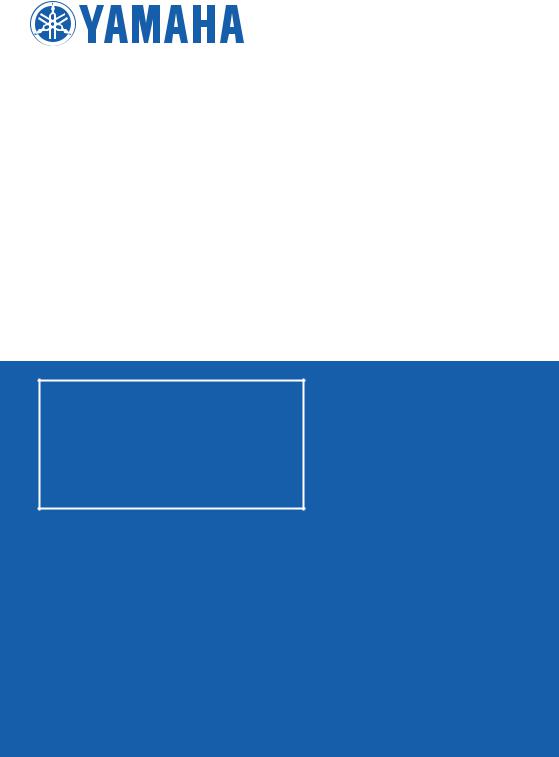
OWNER’S MANUAL
MANUEL DU PROPRIÉTAIRE
BEDIENUNGSANLEITUNG
YZ85
YZ85LW
MOTORCYCLE
MOTO
MOTORRAD
 Read this manual carefully before operating this vehicle.
Read this manual carefully before operating this vehicle.
 Il convient de lire attentivement ce manuel avant la première utilisation du véhicule.
Il convient de lire attentivement ce manuel avant la première utilisation du véhicule.
 Bitte lesen Sie diese Bedienungsanleitung sorgfältig durch, bevor Sie das Fahrzeug in Betrieb nehmen.
Bitte lesen Sie diese Bedienungsanleitung sorgfältig durch, bevor Sie das Fahrzeug in Betrieb nehmen.
YZ85/YZ85H
YZ85LW/YZ85LWH
1SN-28199-85

Original instructions Notice originale Originalbetriebsanleitung
PRINTED ON RECYCLED PAPER |
PRINTED IN JAPAN |
IMPRIMÉ SUR PAPIER RECYCLÉ |
2016.06-0.4×1 CR |
AUF RECYCLINGPAPIER GEDRUCKT |
(E,F,G) |

OWNER’S MANUAL
YZ85
YZ85LW
MOTORCYCLE
 Read this manual carefully before operating this vehicle.
Read this manual carefully before operating this vehicle.
YZ85/YZ85H
YZ85LW/YZ85LWH
1SN-28199-85-E0

EAU46091
 Read this manual carefully before operating this vehicle. This manual should stay with this vehicle if it is sold.
Read this manual carefully before operating this vehicle. This manual should stay with this vehicle if it is sold.

Introduction
EAU41545
Congratulations on your purchase of the Yamaha YZ85 / YZ85H / YZ85LW / YZ85LWH. This model is the result of Yamaha’s vast experience in the production of fine sporting, touring, and pacesetting racing machines. It represents the high degree of craftsmanship and reliability that have made Yamaha a leader in these fields.
This manual will give you an understanding of the operation, inspection, and basic maintenance of this motorcycle. If you have any questions concerning the operation or maintenance of your motorcycle, please consult a Yamaha dealer.
Yamaha continually seeks advancements in product design and quality. Therefore, while this manual contains the most current product information available at the time of printing, there may be minor discrepancies between your motorcycle and this manual. If there is any question concerning this manual, please consult a Yamaha dealer.
EWA10032
 WARNING
WARNING
Please read this manual carefully and completely before operating this motorcycle.
EWA14352
 WARNING
WARNING
This motorcycle is designed and manufactured for off-road use only. It is illegal to operate this motorcycle on any public street, road or highway. Such use is prohibited by law. This motorcycle complies with almost all state offhighway noise level and spark arrester laws and regulations. Please check your local riding laws and regulations before operating this motorcycle.
AN IMPORTANT SAFETY MESSAGE:
Read this manual completely before operating your motorcycle. Make sure you understand all instructions.
Pay close attention to the warning and notice labels on the motorcycle.
Never operate a motorcycle without proper training or instruction.
AN IMPORTANT NOTE TO PARENTS:
This motorcycle is not a toy. Before you let your child ride this motorcycle, you should understand the instructions and warnings in this Owner’s Manual. Then be sure your child understands and will follow them. Children differ in skills, physical abilities, and judgment. Some children may not be able to operate a motorcycle safely. Parents should supervise their child’s use of the motorcycle at all times. Parents should permit continued use only if they determine that the child has the ability to operate the motorcycle safely.

Introduction
Motorcycles are single track vehicles. Their safe use and operation are dependent upon the use of proper riding techniques as well as the expertise of the operator. Every operator should know the following requirements before riding this motorcycle.
He or she should:
Obtain thorough instructions from a competent source on all aspects of motorcycle operation.
Observe the warnings and maintenance requirements in this Owner’s Manual.
Obtain qualified training in safe and proper riding techniques.
Obtain professional technical service as indicated in this Owner’s Manual and/or when made necessary by mechanical conditions.
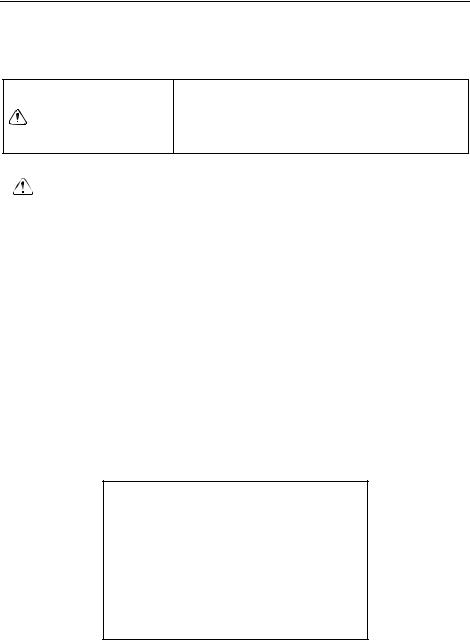
Important manual information
EAU63350
Particularly important information is distinguished in this manual by the following notations:
This is the safety alert symbol. It is used to alert you to potential personal injury hazards. Obey all safety messages that follow this symbol to avoid possible injury or death.
|
|
|
|
A WARNING indicates a hazardous situation |
|
|
WARNING |
|
which, if not avoided, could result in death or |
||
|
|
|
|
serious injury. |
|
|
|
|
|
|
|
|
|
|
|
|
|
|
|
|
|
A NOTICE indicates special precautions that |
|
|
NOTICE |
|
must be taken to avoid damage to the vehi- |
||
|
|
|
|
cle or other property. |
|
|
|
|
|
|
|
|
|
|
|
|
|
TIP |
A TIP provides key information to make proce- |
||||
dures easier or clearer. |
|||||
|
|
|
|
||
|
|
|
|
|
|
*Product and specifications are subject to change without notice.
EAU10201
YZ85 / YZ85H / YZ85LW / YZ85LWH
OWNER’S MANUAL
©2016 by Yamaha Motor Co., Ltd. 1st edition, May 2016
All rights reserved.
Any reprinting or unauthorized use without the written permission of Yamaha Motor Co., Ltd.
is expressly prohibited. Printed in Japan.

Table of contents
Location of important labels........... |
1-1 |
Safety information............................ |
2-1 |
Description ....................................... |
3-1 |
Left view ......................................... |
3-1 |
Right view....................................... |
3-2 |
Controls and instruments ............... |
3-3 |
Instrument and control functions... |
4-1 |
Handlebar switch............................ |
4-1 |
Clutch lever .................................... |
4-1 |
Shift pedal ...................................... |
4-2 |
Brake lever...................................... |
4-2 |
Brake pedal .................................... |
4-3 |
Fuel tank cap.................................. |
4-3 |
Fuel................................................. |
4-4 |
Fuel tank breather hose.................. |
4-6 |
Fuel cock ........................................ |
4-6 |
Starter (choke) knob ....................... |
4-7 |
Kickstarter ...................................... |
4-7 |
Seat ................................................ |
4-8 |
Adjusting the front fork................... |
4-8 |
Front fork bleeding ....................... |
4-10 |
Adjusting the shock absorber |
|
assembly ................................... |
4-10 |
Removable sidestand................... |
4-13 |
For your safety – pre-operation |
|
checks............................................... |
5-1 |
Operation and important riding |
|
points ................................................ |
6-1 |
Starting and warming up a cold |
|
engine ......................................... |
6-1 |
Starting a warm engine .................. |
6-2 |
Shifting ........................................... |
6-2 |
Engine break-in .............................. |
6-3 |
Parking ........................................... |
6-5 |
Periodic maintenance and |
|
adjustment........................................ |
7-1 |
Periodic maintenance and |
|
lubrication chart .......................... |
7-2 |
Checking the spark plug ................ |
7-6 |
Transmission oil.............................. |
7-7 |
Coolant............................................ |
7-8 |
Cleaning the air filter element ....... |
7-10 |
Adjusting the carburetor ............... |
7-12 |
Adjusting the engine idling |
|
speed ......................................... |
7-13 |
Adjusting the throttle grip free |
|
play ............................................ |
7-13 |
Tires .............................................. |
7-14 |
Spoke wheels................................ |
7-16 |
Adjusting the clutch lever free |
|
play ............................................ |
7-17 |
Checking the brake lever free |
|
play ............................................ |
7-18 |
Checking the shift pedal ............... |
7-18 |
Checking the front and rear brake |
|
pads........................................... |
7-19 |
Checking the brake fluid level....... |
7-20 |
Changing the brake fluid............... |
7-21 |
Drive chain slack ........................... |
7-21 |
Cleaning and lubricating the |
|
drive chain ................................. |
7-23 |
Checking and lubricating the |
|
cables ........................................ |
7-23 |
Checking and lubricating the |
|
throttle grip and cable ............... |
7-24 |
Checking and lubricating the |
|
brake and clutch levers ............. |
7-24 |
Checking and lubricating the |
|
brake pedal................................ |
7-25 |
Lubricating the rear suspension.... |
7-25 |
Lubricating the swingarm pivots... |
7-26 |
Checking the front fork ................. |
7-26 |
Checking the steering ................... |
7-27 |
Checking the wheel bearings........ |
7-27 |
Supporting the motorcycle ........... |
7-28 |
Front wheel ................................... |
7-28 |
Rear wheel .................................... |
7-29 |
Troubleshooting ............................ |
7-31 |
Troubleshooting charts ................. |
7-32 |
Motorcycle care and storage .......... |
8-1 |
Matte color caution ......................... |
8-1 |
Care................................................. |
8-1 |
Storage............................................ |
8-3 |

Table of contents
Specifications ................................... |
9-1 |
Consumer information ................... |
10-1 |
Identification numbers................... |
10-1 |
Index ................................................ |
11-1 |
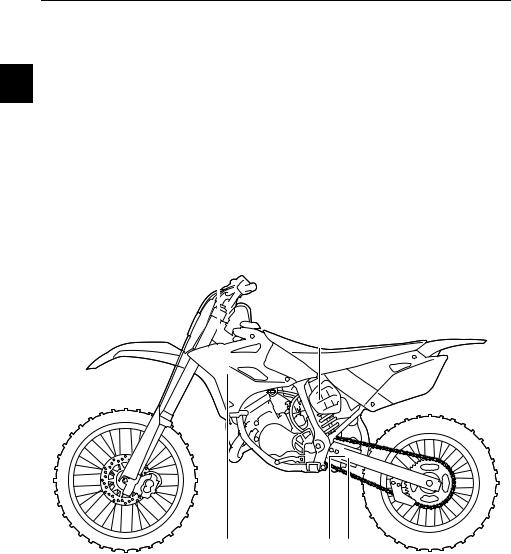
Location of important labels
EAU66341
Read and understand all of the labels on your vehicle. They contain important information for safe and proper operation of your vehicle. Never remove any labels
1from your vehicle. If a label becomes difficult to read or comes off, a replacement label is available from your Yamaha dealer.
For Canada
1,2,3 |
4 |
5 |
6,7 |
||||||
|
|
|
|
|
|
|
|
|
|
|
|
|
|
|
|
|
|
|
|
|
|
|
|
|
|
|
|
|
|
|
|
|
|
|
|
|
|
|
|
|
|
|
|
|
|
|
|
|
|
|
|
|
|
|
|
|
|
|
|
10 |
9 |
8 |
1-1
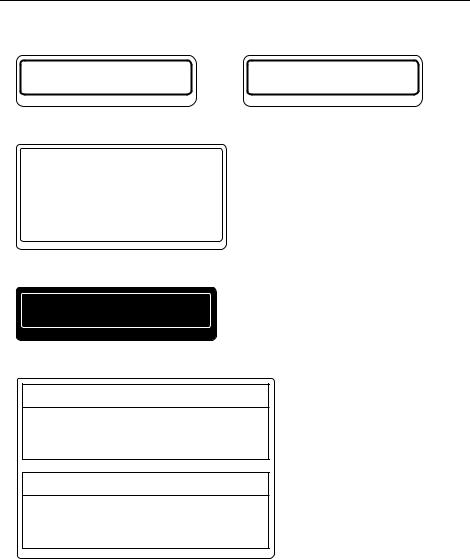
Location of important labels
For Canada |
|
|
|
|
1 |
2 |
|
|
|
Use premium unleaded |
Utiliser de préférence un mélange |
|
|
|
|
1 |
|
||
gasoline / oil premix only. |
huile/super sans plomb. |
|
|
|
3XJ-2415E-A1 |
3XJ-2415E-B1 |
|
|
|
|
|
|
3
4SR-2416E-00
4
CAN ICES-2 / NMB-2
8KM-82377-30
5
1-2

Location of important labels
For Canada
6
 WARNING
WARNING
1
 BEFORE YOU OPERATE THIS VEHICLE, READ
BEFORE YOU OPERATE THIS VEHICLE, READ
THE OWNER’S MANUAL AND ALL LABELS.  NEVER CARRY A PASSENGER. You increase
NEVER CARRY A PASSENGER. You increase
your risk of losing control if you carry a passenger.  NEVER OPERATE THIS VEHICLE ON PUBLIC ROADS. You can collide with another vehicle if
NEVER OPERATE THIS VEHICLE ON PUBLIC ROADS. You can collide with another vehicle if
you operate this vehicle on a public road.
 ALWAYS WEAR AN APPROVED MOTORCYCLE HELMET, eye protection, and protective clothing.
ALWAYS WEAR AN APPROVED MOTORCYCLE HELMET, eye protection, and protective clothing.  EXPERIENCED RIDER ONLY.
EXPERIENCED RIDER ONLY.
5PA-2118K-00
7
 AVERTISSEMENT
AVERTISSEMENT
 LIRE LE MANUEL DU PROPRIETAIRE AINSI QUE TOUTES LES ETIQUETTES AVANT D’UTILISER CE VEHICULE.
LIRE LE MANUEL DU PROPRIETAIRE AINSI QUE TOUTES LES ETIQUETTES AVANT D’UTILISER CE VEHICULE.
 NE JAMAIS TRANSPORTER DE PASSAGER. La conduite avec passager augmente les risques de perte de contrôle.
NE JAMAIS TRANSPORTER DE PASSAGER. La conduite avec passager augmente les risques de perte de contrôle.
 NE JAMAIS ROULER SUR DES CHEMINS PUBLICS. Vous pourriez entrer en collision avec un autre véhicule.
NE JAMAIS ROULER SUR DES CHEMINS PUBLICS. Vous pourriez entrer en collision avec un autre véhicule.
 TOUJOURS PORTER UN CASQUE DE MOTOCYCLISTE APPROUVE, des lunettes et des vêtements de protection.
TOUJOURS PORTER UN CASQUE DE MOTOCYCLISTE APPROUVE, des lunettes et des vêtements de protection.  EXCLUSIVEMENT POUR L’USAGE D’UN CONDUCTEUR EXPERIMENTE.
EXCLUSIVEMENT POUR L’USAGE D’UN CONDUCTEUR EXPERIMENTE.
5PA-2118K-10
8
TIRE INFORMATION
Cold tire normal pressure should be set as follows.
FRONT : 100kPa, {1.00kgf/cm2}, 15psi REAR : 100kPa, {1.00kgf/cm2}, 15psi
3RV-21668-A0
9
INFORMATION SUR LES PNEUS
La pression des pneus à froid doit normalement être réglée comme suit.
AVANT : 100kPa, {1.00kgf/cm2}, 15psi ARRIERE : 100kPa, {1.00kgf/cm2}, 15psi
3RV-21668-B0
10
|
|
|
|
NA |
|
|
|
|
|
|
|
A |
D |
|
|
||
|
|
C |
|
|
A |
• |
|
|
S |
S |
• |
|
|
|
|
N |
|
|
|
|
|
|
|
V |
||
V |
|
|
|
|
|
|
S |
|
|
|
506 |
|
C |
||||
M |
|
|
||||||
|
|
|
|
|
|
|
|
A |
C |
|
|
|
|
|
|
• |
|
• |
|
|
|
|
|
|||
|
|
|
|
|
T |
|||
|
T |
|
|
|
|
R |
||
|
|
R |
A |
|
|
|
|
|
|
|
|
|
|
O |
|
||
|
|
|
|
NSP |
|
|
||
1-3
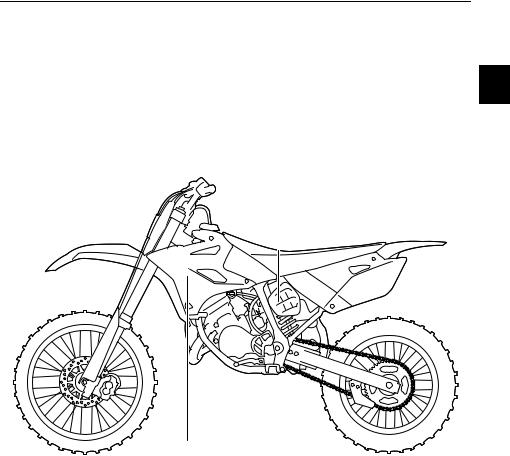
Location of important labels
For Europe
1
1 |
2 |
||||
|
|
|
|
|
|
|
|
|
|
|
|
|
|
|
|
|
|
|
|
|
|
|
|
|
|
|
|
|
|
3
1-4
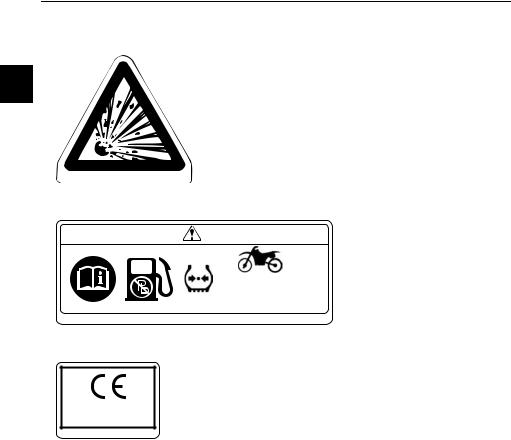
Location of important labels
For Europe
1
1
4AA-22259-40
2
100 kPa 100 kPa
1.00 kgf/cm² 1.00 kgf/cm²
15 psi |
15 psi |
|
5PG-2816R-00 |
3
YAMAHA MOTOR CO., LTD.
SHIZUOKA JAPAN
YAMAHA |
4GB-2155A-00 |
1-5
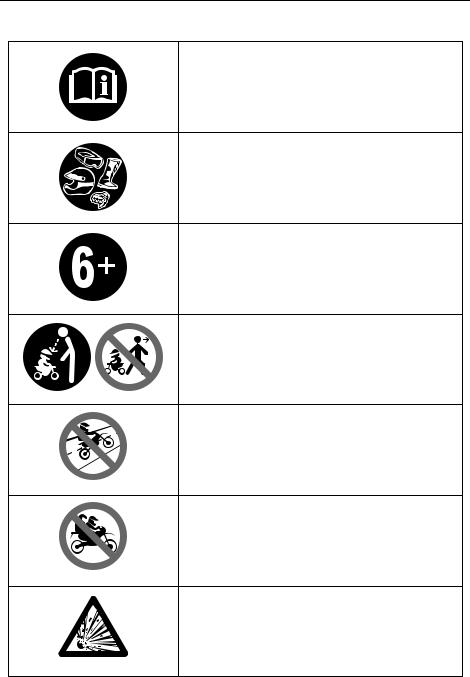
Location of important labels
Familiarize yourself with the following pictograms and read the explanatory text.
Read the Owner’s manual. |
1 |
|
|
Always use an approved helmet and protective gear.
Use from 6 years old.
Operation of this motorcycle by children under the age of 6 increase the risk of severe injury or death.
Adult supervision required for children.
Never use on paved roads.
Never carry passengers.
This unit contains high-pressure nitrogen gas. Mishandling can cause an explosion. Do not incinerate, puncture or open.
1-6
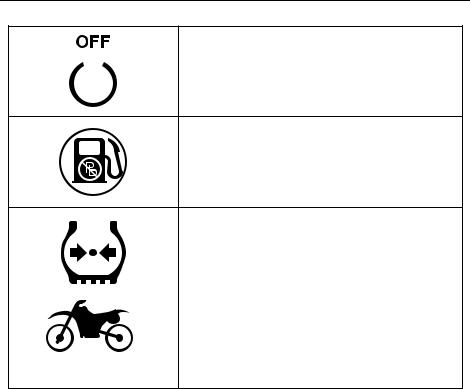
Location of important labels
|
|
|
|
|
Turn off the main switch after riding to avoid |
|
|
|
|||
|
1 |
|
|
|
draining the battery. |
|
|
|
|
|
|
|
|
|
|
|
|
Use unleaded gasoline only.
|
|
Measure the tire pressure when the tires are |
|
|
cold. |
|
|
|
|
|
Adjust the tire pressure. |
|
|
Improper tire pressure can cause loss of |
|
|
control. |
**.* kPa |
**.* kPa |
Loss of control can result in severe injury or |
*.** kgf/cm² |
*.** kgf/cm² |
death. |
|
||
*.* psi |
*.* psi |
|
1-7
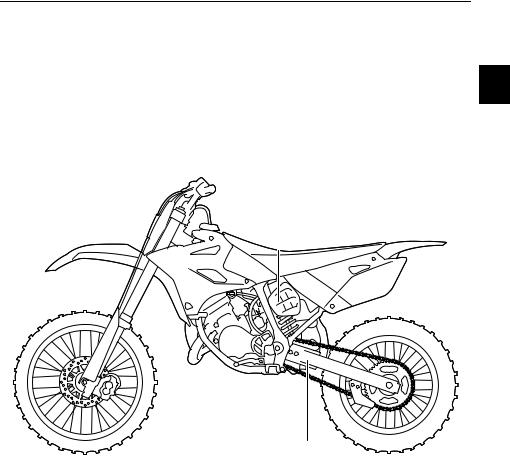
Location of important labels
For Oceania and South Africa
1
1 |
2 |
||||
|
|
|
|
|
|
|
|
|
|
|
|
|
|
|
|
|
|
|
|
|
|
|
|
|
|
|
|
|
|
3
1-8
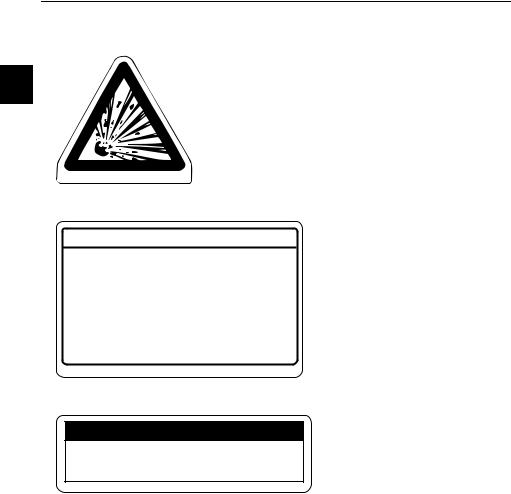
Location of important labels
For Oceania and South Africa
1
1
4AA-22259-40
2
 WARNING
WARNING
 BEFORE YOU OPERATE THIS VEHICLE, READ THE OWNER’S MANUAL AND ALL LABELS.
BEFORE YOU OPERATE THIS VEHICLE, READ THE OWNER’S MANUAL AND ALL LABELS.
 NEVER CARRY A PASSENGER. You increase your risk of losing control if you carry a passenger.
NEVER CARRY A PASSENGER. You increase your risk of losing control if you carry a passenger.
 NEVER OPERATE THIS VEHICLE ON PUBLIC ROADS. You can collide with another vehicle if you operate this vehicle on a public road.
NEVER OPERATE THIS VEHICLE ON PUBLIC ROADS. You can collide with another vehicle if you operate this vehicle on a public road.
 ALWAYS WEAR AN APPROVED MOTORCYCLE HELMET, eye protection, and protective clothing.
ALWAYS WEAR AN APPROVED MOTORCYCLE HELMET, eye protection, and protective clothing.  EXPERIENCED RIDER ONLY.
EXPERIENCED RIDER ONLY.
5PA-2118K-00
3
TIRE INFORMATION
Cold tire normal pressure should be set as follows.
FRONT : 100kPa, {1.00kgf/cm2}, 15psi REAR : 100kPa, {1.00kgf/cm2}, 15psi
3RV-21668-A0
1-9

 Safety information
Safety information
EAU41469
Be a Responsible Owner
As the vehicle’s owner, you are responsible for the safe and proper operation of your motorcycle.
Motorcycles are single-track vehicles. Their safe use and operation are dependent upon the use of proper riding techniques as well as the expertise of the operator. Every operator should know the following requirements before riding this motorcycle.
He or she should:
Obtain thorough instructions from a competent source on all aspects of motorcycle operation.
Observe the warnings and maintenance requirements in this Owner’s Manual.
Obtain qualified training in safe and proper riding techniques.
Obtain professional technical service as indicated in this Owner’s Manual and/or when made necessary by mechanical conditions.
Never operate a motorcycle without proper training or instruction. Take a training course. Beginners should receive training from a certified instructor. Contact an authorized motorcycle dealer to find out about the training courses nearest you.
Safe Riding
Perform the pre-operation checks each time you use the vehicle to make sure it is in safe operating condition. Failure to inspect or maintain the vehicle properly increases the possibility of
an accident or equipment damage. See page 5-1 for a list of pre-operation checks.
This motorcycle is designed for off-road use only, therefore, it is illegal to operate it on public streets, roads, or highways, even
a dirt or gravel one. Off-road use 2 on public lands may be illegal. Please check local regulations before riding.
This motorcycle is designed to carry the operator only. No passengers.
The failure of motorists to detect and recognize motorcycles in traffic is the predominating cause of automobile/motorcycle accidents. Many accidents have been caused by an automobile driver who did not see the motorcycle. Making yourself conspicuous appears to be very effective in reducing the chance of this type of accident.
Therefore:
•Wear a brightly colored jacket.
•Use extra caution when you are approaching and passing through intersections, since intersections are the most likely places for motorcycle accidents to occur.
•Ride where other motorists can see you. Avoid riding in another motorist’s blind spot.
•Never maintain a motorcycle without proper knowledge. Contact an authorized motorcycle dealer to inform you on ba-
2-1

 Safety information
Safety information
sic motorcycle maintenance. Certain maintenance can only be carried out by certified staff.
Many accidents involve inexperienced operators.
•Make sure that you are qualified and that you only lend your mo-
2torcycle to other qualified operators.
•Know your skills and limits. Staying within your limits may help you to avoid an accident.
•We recommend that you practice riding your motorcycle until you have become thoroughly familiar with the motorcycle and all of its controls.
Many accidents have been caused by error of the motorcycle operator. A typical error made by the operator is veering wide on a turn due to excessive speed or undercornering (insufficient lean angle for the speed). Never travel faster than warranted by conditions.
Ride cautiously in unfamiliar areas. You may encounter hidden obstacles that could cause an accident.
Protective Apparel
The majority of fatalities from motorcycle accidents are the result of head injuries. The use of a safety helmet is the single most critical factor in the prevention or reduction of head injuries.
Always wear an approved helmet.
Wear a face shield or goggles. Wind in your unprotected eyes could contribute to an impairment of vision that could delay seeing a hazard.
The use of a jacket, heavy boots, trousers, gloves, etc., is effective in preventing or reducing abrasions or lacerations.
Never wear loose-fitting clothes, otherwise they could catch on the control levers, footrests, or wheels and cause injury or an accident.
Always wear protective clothing that covers your legs, ankles, and feet. The engine or exhaust system become very hot during or after operation and can cause burns.
Avoid Carbon Monoxide Poisoning
All engine exhaust contains carbon monoxide, a deadly gas. Breathing
The posture of the operator is imcarbon monoxide can cause headportant for proper control. The opaches, dizziness, drowsiness, nausea,
erator should keep both hands on the handlebar and both feet on the operator footrests during operation to maintain control of the motorcycle.
Never ride under the influence of alcohol or other drugs.
Be sure the transmission is in neutral before starting the engine.
confusion, and eventually death. Carbon Monoxide is a colorless, odorless, tasteless gas which may be present even if you do not see or smell any engine exhaust. Deadly levels of carbon monoxide can collect rapidly and you can quickly be overcome and unable to save yourself. Also, deadly levels of carbon monoxide can linger for hours or days in enclosed or poorly
2-2

 Safety information
Safety information
ventilated areas. If you experience any symptoms of carbon monoxide poisoning, leave the area immediately, get fresh air, and SEEK MEDICAL TREATMENT.
Do not run engine indoors. Even if you try to ventilate engine exhaust with fans or open windows and doors, carbon monoxide can rapidly reach dangerous levels.
Do not run engine in poorly ventilated or partially enclosed areas such as barns, garages, or carports.
Do not run engine outdoors where engine exhaust can be drawn into a building through openings such as windows and doors.
Genuine Yamaha Accessories
Choosing accessories for your vehicle is an important decision. Genuine Yamaha accessories, which are available only from a Yamaha dealer, have been designed, tested, and approved by Yamaha for use on your vehicle.
Many companies with no connection to Yamaha manufacture parts and accessories or offer other modifications for Yamaha vehicles. Yamaha is not in a position to test the products that these aftermarket companies produce. Therefore, Yamaha can neither endorse nor recommend the use of accessories not sold by Yamaha or modifications not specifically recommended by Yamaha, even if sold and installed by a Yamaha dealer.
Aftermarket Parts, Accessories, and Modifications
While you may find aftermarket products similar in design and quality to genuine Yamaha accessories, recognize that some aftermarket accessories or modifications are not suitable
because of potential safety hazards to 2 you or others. Installing aftermarket products or having other modifications performed to your vehicle that change
any of the vehicle’s design or operation characteristics can put you and others at greater risk of serious injury or death. You are responsible for injuries related to changes in the vehicle.
Keep the following guidelines in mind, as well as those provided under “Loading” when mounting accessories.
Never install accessories that would impair the performance of your motorcycle. Carefully inspect the accessory before using it to make sure that it does not in any way reduce ground clearance or cornering clearance, limit suspension travel, steering travel or control operation.
•Accessories fitted to the handlebar or the front fork area can create instability due to improper weight distribution. If accessories are added to the handlebar or front fork area, they must be as lightweight as possible and should be kept to a minimum.
•Bulky or large accessories may seriously affect the stability of the motorcycle. Wind may at-
2-3

 Safety information
Safety information
tempt to lift the motorcycle, or the motorcycle may become unstable in cross winds.
•Certain accessories can displace the operator from his or
her normal riding position. This improper position limits the
2freedom of movement of the operator and may limit control ability, therefore, such accessories are not recommended.
Use caution when adding electrical accessories. If electrical accessories exceed the capacity of the motorcycle’s electrical system, an electric failure could result, which could cause a dangerous loss of lights or engine power.
Aftermarket Tires and Rims
The tires and rims that came with your motorcycle were designed to match the performance capabilities and to provide the best combination of handling, braking, and comfort. Other tires, rims, sizes, and combinations may not be appropriate. Refer to page 7-14 for tire specifications and more information on replacing your tires.
Transporting the Motorcycle
Be sure to observe following instructions before transporting the motorcycle in another vehicle.
Remove all loose items from the motorcycle.
Check that the fuel cock (if equipped) is in the “OFF” position and that there are no fuel leaks.
Point the front wheel straight ahead on the trailer or in the truck bed, and choke it in a rail to prevent movement.
Shift the transmission in gear (for models with a manual transmission).
Secure the motorcycle with tiedowns or suitable straps that are attached to solid parts of the motorcycle, such as the frame or upper front fork triple clamp (and not, for example, to rubber-mounted handlebars or turn signals, or parts that could break). Choose the location for the straps carefully so the straps will not rub against painted surfaces during transport.
The suspension should be compressed somewhat by the tiedowns, if possible, so that the motorcycle will not bounce excessively during transport.
2-4
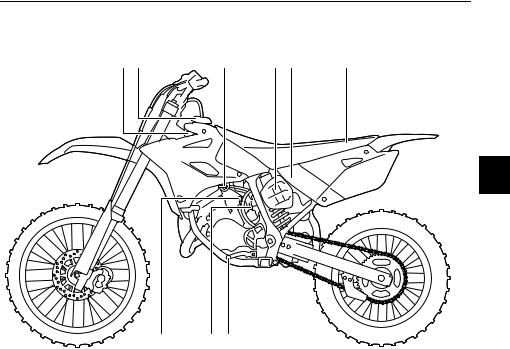
Description
EAU63371
Left view
1 2 |
3 |
4 5 |
6 |
3
9 |
8 |
7 |
1.Radiator cap (page 7-8)
2.Fuel tank cap (page 4-3)
3.Fuel cock (page 4-6)
4.Shock absorber assembly spring preload adjusting nut (page 4-10)
5.Air filter element (page 7-10)
6.Seat (page 4-8)
7.Shift pedal (page 4-2)
8.Throttle stop screw (page 7-13)
9.Starter (choke) knob (page 4-7)
3-1
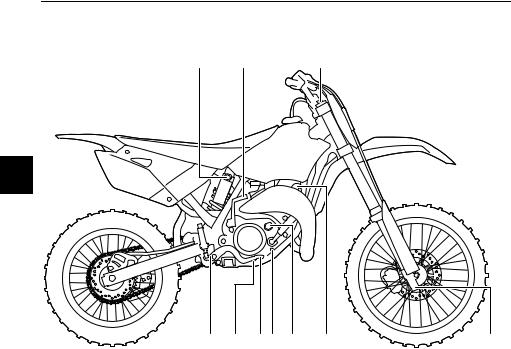
Description
EAU63391
Right view
1 |
2 |
3,4 |
3
11 |
10 |
9 8 |
7 |
6 |
5 |
1.Shock absorber assembly compression damping force adjusting screw (page 4-10)
2.Kickstarter (page 4-7)
3.Front fork rebound damping force adjusting screw (page 4-8)
4.Bleed screw (page 4-10)
5.Front fork compression damping force adjusting screw (page 4-8)
6.Spark plug cap (page 7-6)
7.Transmission oil filler cap (page 7-7)
8.Coolant drain bolt (page 7-9)
9.Brake pedal (page 4-3)
10.Transmission oil drain bolt (page 7-7)
11.Shock absorber assembly rebound damping force adjusting screw (page 4-10)
3-2
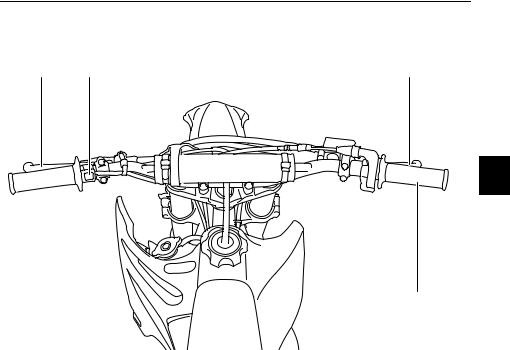
Description
EAU63401
Controls and instruments
1 |
2 |
3 |
3
4
1.Clutch lever (page 4-1)
2.Engine stop switch (page 4-1)
3.Brake lever (page 4-2)
4.Throttle grip (page 7-13)
3-3
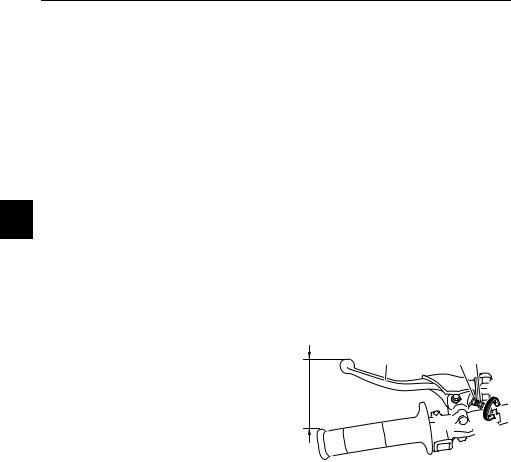
Instrument and control functions
EAU40661
Handlebar switch
1. Engine stop switch “ENGINE STOP”
4
EAU53962
Engine stop switch “ENGINE STOP”
Hold this switch pushed until the engine stops.
EAU64023
Clutch lever
The clutch lever is located on the left side of the handlebar. To disengage the clutch, pull the lever toward the handlebar grip. To engage the clutch, release the lever. The lever should be pulled rapidly and released slowly for smooth clutch operation.
The clutch lever is equipped with a clutch lever position adjusting bolt. Adjust the distance between the clutch lever and the handlebar grip as follows.
1.Loosen the locknut.
2.While holding the clutch lever pulled slightly towards the handlebar grip, turn the adjusting bolt in direction (a) to increase the distance, and in direction (b) to decrease it.
1 |
2 |
3 |
4 |
|
(b) |
|
|




 (a)
(a)
1.Clutch lever
2.Locknut
3.Clutch lever position adjusting bolt
4.Distance between clutch lever and handlebar grip
3.Tighten the locknut.
4-1
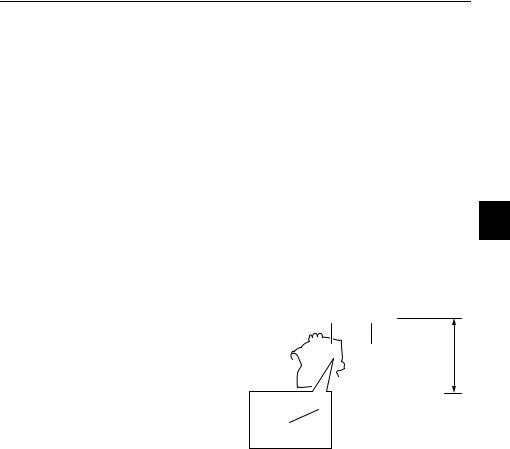
Instrument and control functions
EAU12872
Shift pedal
1. Shift pedal
The shift pedal is located on the left side of the motorcycle and is used in combination with the clutch lever when shifting the gears of the 6-speed con- stant-mesh transmission equipped on this motorcycle.
EAU41267
Brake lever
The brake lever is located on the right side of the handlebar. To apply the front brake, pull the lever toward the throttle grip.
The brake lever is equipped with a brake lever position adjusting bolt. Adjust the distance between the brake lever and the throttle grip as follows.
1.Slide the rubber cover toward the end of the brake lever.
2.Loosen the locknut.
3. While holding the lever pushed |
4 |
away from the throttle grip, turn |
|
the adjusting bolt in direction (a) to |
|
increase the distance, and in di- |
|
rection (b) to decrease it. |
|
1 2
5
(a)4
(b) 3
3
1.Rubber cover
2.Brake lever
3.Locknut
4.Brake lever position adjusting bolt
5.Distance between brake lever and throttle grip
4.Tighten the locknut.
5.Slide the rubber cover to its original position.
4-2
